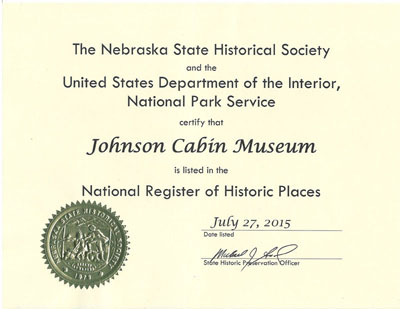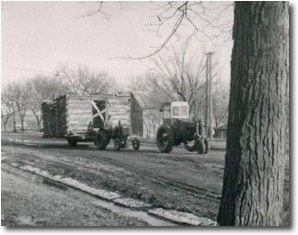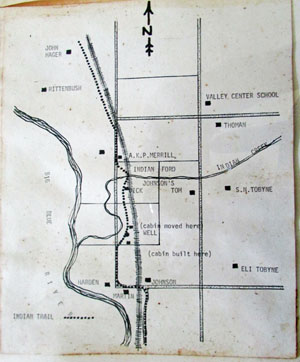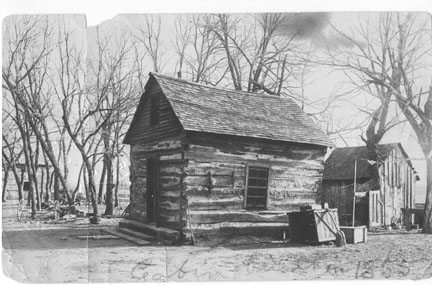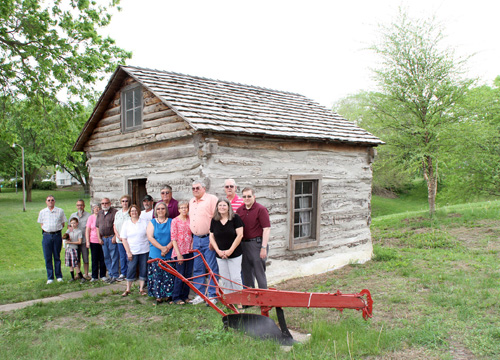TIMELINE
Summer 1855 - Rev James H. Johnson arrives
in Gage County from Mount Pleasant, Iowa with the intention of
ministering to the Otoe-Missouri Reservation. He builds the cabin
(see notarized letter submitted by Edward Clawson - Exhibit)
near the Big Blue River on land as a squatter and returns to
Iowa for the winter.
Summer 1857 - James returns to Gage County with his family (wife
Martha, daughters Mary and Martha and sons, Allen, James and
Richard). That fall Allen drowned in the river and would later
be reinterred to become the first recorded burial in the Methodist
Cemetery (now the Blue Springs Cemetery).
Oct 1859 - James enters into a Bond agreement with Charles T.
Hillyer of Hartford CT to purchase the 160 acres (Twp 002N Rng
007E SE1/4 Sec 9) where the cabin stood for $286.
Sept 1860 - Patent is issued to Charles
T Hillyer for same property. Johnson Family is living in the
Cabin
1862 - Rev. James dies in a typhoid epidemic leaving Martha to
raise her children on the Frontier. James Hollingworth and his
family arrive from Wisconsin and rent the cabin from Martha for
2 seasons. Her family lives in a frame house recently built nearby
on the farmstead.
April 1863 - Hillyer Quit Claims Deed to the property to Johnson
Heirs in receipt of $300
1877 - Martha Johnson Quit Claims the property to her daughter
Mattie Johnson (later Clawson) and the property is owned by Johnson
descendants until Mrs. C. B Cross (granddaughter of James) sells
it in 1946.
1880 criteria - Map of original cabin and surroundings drawn
in 1953 by Edward Clawson, grandson, who was born in the cabin
in 1884. His notes indicate the cabin was moved in its early
years, probably before 1890 where it remained until it was moved
to the City Park in 1949.
1921 - photo of cabin rented by the Tays Family. Mr & Mrs.
Tays (pictured) lived in the cabin that summer and their daughter's
family rented the larger house in the background. (Exhibit)
1946 - Ray Martin purchases the property
1948 - Ray Martin donates the cabin. "Blue
Springs Park Home for Old Cabin" Beatrice Daily Sun
Dec 1948
February 22, 1949 - Cabin is moved to Blue Springs City Park
and funded by donations to the Pioneer Club
Decoration Day 1950 - Johnson Cabin was opened to the public
housing a collection of historic relics & articles donated
by local citizens.
1963 - The City of Blue Springs becomes owner and caretaker of
the Cabin.
Present - The Johnson Cabin Museum is opened on summer holidays,
town picnics & by appointment.

CABIN PRESERVATION STORY
2019-2021
by Jan Eloise Morris

Heavy rainfall in the summer of 2018 crept into the four corners
of the Johnson Cabin Museum for the first time. The restoration
work of the Pioneer Club 70 years before had kept the interior
dry over the years, but large cracks in the concrete floor were
now heaving and unstabilizing the sill logs laid upon it. Outside,
water had found its way beside the 160 year old oak logs recently
encased in well-meaning cement. Decades of rainwater flowing
from higher ground to the north and west of the cabin found its
way under the foundation and had taken its final blow.
In January of 2019, on the recommendations of the Nebraska State
Historical Society, Gene Reedy and I met with Jerry Berggren
of Berggren Architects. Jerry, highly respected for his work
in historic preservation and restoration, offered his consultation
services without charge and provided a detailed plan to save
our historic treasure. He suggested excavating along the southwest
corner to determine the depth of the concrete foundation and
underpinning the existing foundation below frost level in three
foot sections. This process required the interior concrete to
be removed and replaced. The process would be delicate, difficult
to engineer and could not guarantee future cracking of a new
foundation. He also suggested a berm to be put in place to the
north and west to keep future water flow away from the cabin.
In early February, Gene & Radar
Reedy and I met with local contractors; James Ullman, Keith Weyer
and Todd Lineweber to discuss a plan forward. While Jerry's plan
to underpin the cabin would work, a discussion concerning the
cabin's low point in its surroundings presented future drainage
issues. Some of the men had experience in moving cabins and houses
and it was suggested the best solution would be to move the old
cabin 20 foot to the north on higher ground. Two long years later,
I often thing of that day. "Move it 20 feet" they said.
"It will be great" they said ...
That afternoon, I contacted John Williams
of Williams Midwest House Movers, Inc. located in Hastings, they
are the best movers in Nebraska with years of experience with
difficult moving issues. After quite a search, I found Butch
Bouvier in Council Bluffs. Butch did an extensive restoration
of the Mayhew Cabin in Nebraska log by log in 2005, nearly 15
years before. James Ullman & Keith Weyer, our local sawmill
operators, were hired to source and mill 2 new courses of logs
for the bottom of the cabin, as well as install a new oak wood
floor. B&J Hill Construction provided a bid for grading and
new sidewalks. Dustin Martin of Martin Wall Construction provided
a bid to dig and pour new concrete footings. After clearing our
project with the Nebraska State Historical Society and Jerry
Berggren, our search for funding began.
With costs mounting for the project,
our first grant submission was passed over. The $38,000 estimate
was well above their capacity to fund. I then worked with the
City of Blue Springs to formulate submissions for two matching
grants. On June 22, 2019 the Gage County Visitor Improvement
Fund approved 50% funding for our project, which would pay for
$19,000 of approved expenses upon completion. The City of Blue
Springs agreed to front the costs until completion of their portion.
On July 25, 2019 the Margaret & Martha Thomas Foundation
approved and funded the 2nd half of the project.

On July 12th, the cabin made an appearance
on Pure Nebraska, the last documented filming of the cabin in
its 2nd chapter of existence.
Step Back in Time at the Johnson Cabin Museum
On August 9th 28 kids from Lincoln's
Little Kingdom were the last group to tour the museum to date.
The Work Begins

On August 19, 2019 Dustin Martin arrived to dig the footings
and pour the concrete for the new foundation. Dustin's grandfather,
Ray Martin, donated the shell of the old cabin to the Pioneer
Club 70 years before and it was moved to the park on February
22, 1949.

On August 29th, with the help of Gene Reedy and Dave Friedeman,
we packed up the cabin contents and moved them to Blue Springs
City Hall for safe keeping.

Early on the morning of September 5th, John Williams of Williams
Midwest House Movers arrived to move the cabin. They spent the
morning sawing through the decayed bottom logs, shoring up the
delicate old log walls and brick chimney with steel. In the afternoon
they placed steel rails and a ball bearing system over to and
above the new concrete footings. Early the next morning the structure
was smoothly moved over its new footings.
Butch Bouvier arrived with his young
assistant to go over the details of the cabin with John Williams
and stayed to take measurements and talk over the work ahead
with James Ullman who would be providing the hewn logs for replacement
on the new concrete sill. Once this was accomplished the movers
would come back and set the cabin on its new logs. While, all
of the contractors involved in this process were seasoned experts,
none of this work had been linked together before. John Williams
supported the delicate walls and brick chimney with enough steel
beams to keep the building stable, a procedure which would prove
to save the structure in the months ahead.
Meanwhile, Bouvier, who had recently
been through heart surgery and had taken on another cabin project
closer to his home, seemed a bit overwhelmed by the steel beams
he would need to work around. A week later, he ended up in the
emergency room with fluid around his heart and had to back out
of his commitment to the project.

After nearly two months of stressful searching for a log expert
to replace Butch, I sent photos to Bob Savage of 888-Log-Guys
near Springfield, Missouri asking them for an estimate. Bob
returned a plan within a week on how to replace the logs and
thought they could work with our budget. Radar & Gene Reedy
and James Ullman took over the logistics of the project.
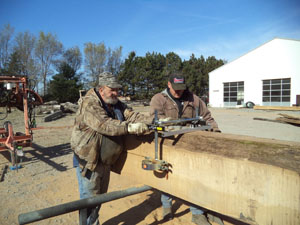
James found oak logs south of Wymore. The oak trees that became
the logs were harvested from Oren & Kathryn Bednar's land
in Range 6 Township 2 Section 36 of Sicily Township. For over
100 years, they grew along Otoe Creek. They were cut down over
10 years ago, which fit our purpose well as the logs needed for
the cabin could not be green.
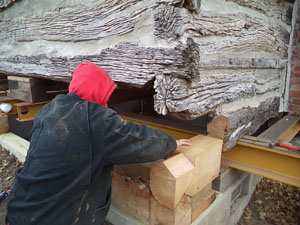
The 888- Log-Guys crew arrived late
on the rainy afternoon of November 18th. The logs were delivered
the next morning and other materials were sourced in Beatrice.
The crew began work on the east and west walls where there was
less presence of steel beams. The next day, William's Midwest
Movers returned to pull the beams from the north and south side,
set the cabin down on the new logs now carrying the weight of
the cabin on the east and west side. After the movers shored
up the brick chimney while it waited for masons to replace the
bricks at the base, the log crew installed the new logs on the
north and south sides of the cabin. On Saturday, with the help
of Radar and Gene, they worked until after dark to finish the
job. Without question, we owe a huge debt of gratitude to, Todd,
the antique cabin expert and his assistant from 888-Log-Guys
who literally saved the structure and came in under budget.
When we were cleaning up the grounds on November 23rd, Linda
Hohensee found a 2019 penny on the grounds, knowing it was a
lucky penny I kept it for the cabin collection. A few days later
I noticed we are carrying on an old cabin tradition when I came
across a letter from the Johnson family who found an 1857 one
cent piece on the original grounds of the cabin and kept it as
a remembrance.

With winter setting in, work again slowed down. There was enough
oak material left for oak flooring and James and Keith went to
work on the new oak flooring complete with a trap door to access
the floor below. James also adjusted the walnut door to fit its
new opening.
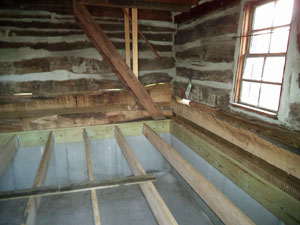
Van Winkle Masonry came to repair the brick
chimney with locally sourced antique bricks. We were very fortunate
to find bricks that match, donated by Thelma Anderson. The original
cabin bricks were salvaged from the ruins of the Blue Springs
Methodist Church 1882-1948.
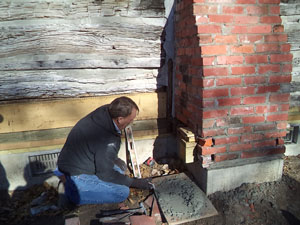
In March, Radar and Gene donated more
time and equipment to remove the old cabin foundation and clean
up the grounds.
On May 1st, B & J Hill Construction
did rough grading of the grounds and installed handicap access
sidewalks. Schmale Lawn & Landscape worked the last week
of May to fine grade the grounds and seeded with a fescue blend.
With these projects complete, the City of Blue Springs commitments
to the two matching grants were complete and a request for final
payment of the 2nd grant was sent to the Gage County Advisory
Committee in June and the City was reimbursed the full $19,000
commitment. We wish to thank the City of Blue Springs for their
understanding and support throughout this preservation.

When it was determined that due to the Covid Pandemic, the museum
could not open for the summer of 2020, work again slowed on finishing
the cabin. Gene spent most of the summer filling in between the
new logs for chinking and maintaining the new grass. Having lost
some of it in the heat of summer, a new seeding was done again
in the fall.

As part of my contribution to the 3rd
chapter of the cabin's history, I planted 2 deep purple lilacs
which were transplanted from our family farm. My Dad, Robert
Morris, and I transplanted them from my grandparents farm
to our farm in the late 1950s. They were originally planted by
the CCC boys on my grandparent's farm in the 1930s to control
erosion.
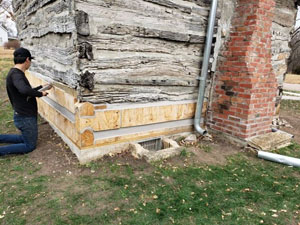
With a small amount of money left over
and several hundred additional funding from the City, the 888
Log guys returned in October, 2020 to chink the exterior of the
building before another winter set in.
This spring, 2021, Rosalee & Gene
Reedy, working on behalf of the City of Blue Springs received
donations from the Wymore Blue Springs Area Fund and The
Gage County Foundation. The 888 Log Guy's crew returned in
early July 2021 to complete the interior & additional exterior
chinking. The Cabin and Exhibits were cleaned and moved back
the week of August 8th.
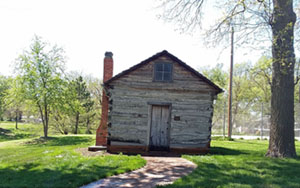 First re-opening August 14,
2021
First re-opening August 14,
2021
The Blue Springs Celebration.

